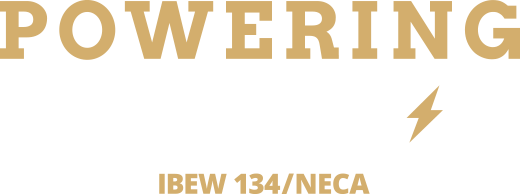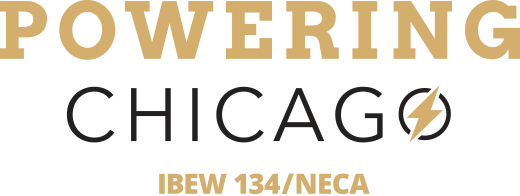Powering Chicago’s Guide to Safe Holiday Light Installation
- Posted: November 16, 2023
- better careers, better communities, better construction, Holiday Lighting Tips, Holiday Lights, IBEW Local 134, Jerry McGlynn, McWilliams Electric Company, qualified electrical contractor, Safety, Training
By Jerry McGlynn, CESCP, CHST, STSC
Vice President of Field Operations & Safety at McWilliams Electric
The holidays are here, and homes across the United States are lighting up with outdoor festive decorations. As you deck out the exterior of your home, keep electrical safety in mind. Data shows that electrical issues, specifically distribution and lighting equipment, play a significant role in holiday-related incidents, being implicated in 45% of Christmas tree fires in homes. To ensure your home is both safe and festively lit, Powering Chicago member and McWilliams Electric Company Vice President of Field Operations & Safety Jerry McGlynn offers valuable tips to keep your holiday displays not only merry and bright but also secure and incident-free.
- Inspect Lights Thoroughly
Carefully inspect all holiday light strands for cracked sockets, damaged cords, loose connections, or broken bulbs before using. It’s a critical step, as statistics reveal that decorative lights are a factor in 17% of home fire incidents related to holiday decorations. Even the smallest crack can reveal hazardous live wires, while aged and brittle cords may lead to electrical shorts. Lights that show any sign of damage can significantly increase the risk of electrocution, electrical fires, and damage to your property. To maintain a safe holiday atmosphere, it’s essential to responsibly discard any defective lights. Remember, fixing damaged light sets is not a DIY job — leave it to the professionals.
- Use Clips for Cords
When securing your festive lights, be mindful that cords or plugs were involved in 7% of Christmas tree fires. Avoid pinning or stapling extension cords in place, as this can damage the protective insulation and expose bare wires to contact. Instead, use plastic hooks, clips, or zip ties to neatly secure cords along walls or railings. Position them out of high-traffic areas so they are not tugged loose or damaged.
- Keep Lights Away From Heat
When setting up your holiday lights outside, be mindful of where you place them. Keep them away from roof vents, and don’t let them rest against exterior walls that may get warm. Heat can weaken and damage the cords over time, making them brittle and more likely to crack. It’s also important to fasten the lights securely, ensuring that cords aren’t touching any surfaces that heat up, like window frames or active light bulbs. Not only can melting plastic from too much heat release harmful fumes, but it can also create a fire hazard.
- Unplug First for Safety
Always unplug holiday light strands at the outlet before installing, removing, or making any adjustments. Do not just flip off a switch – physically unplug the cord. Making this a consistent practice prevents accidental electric shocks or damage to the lights, which is critical given that electrical failures or malfunctions were factors in almost one-third of Christmas tree fires.
- Use Heavy Duty Outdoor Cords
Choose outdoor-rated extension cords that can endure weather and heavy usage, a crucial step given that wiring problems contribute significantly to home fire incidents. Look for durable cords marked SPT-3 or with a 12 or 14-gauge wire designed for outdoor stress. Avoid using indoor cords outside as they may overheat and cause fires. Always inspect cords for damage like cracks or fraying, and ensure they have no exposed wires or loose connections. For added protection, use cords marked SJT, as they have the necessary protective jacket for outdoor use.
- Don’t Overload Cords
Check the amperage rating printed on extension cords and do not exceed it. Overloading cords by plugging in too many light strands can lead to overheating, melted plastic, or even electrical fires. As a general guide, a single outdoor extension cord can safely support about four standard C7 light strands. If you need to run more strands, use multiple cords to spread out the electrical load.
They make extension cords with plugs along the cord for Holiday Lights. Plugging too many strands into one outlet risks fire hazards.
- Elevate Outdoor Cords
When running extension cords outdoors, elevate them off the ground and do not let them dangle into snow piles where moisture can seep into connections. Water and snow exposure leads to short-circuiting and can shock anyone handling cords. Secure cords neatly using clips so they are out of standing water and protected from winter precipitation along their full length.
- Use a Ladder
It’s important to use a ladder when installing holiday lights on your roof. Avoid hanging over the edge of your roof when installing lights. Be sure your ladder is fully functioning properly before climbing it to your roof or other high spaces for light installation.
- Hire an Electrician If Needed:
For large, elaborate displays, consider hiring a professional, qualified electrician for installation. They can ensure optimal wiring gauges for set size and visibility. Electricians properly fuse connections and use waterproof junction boxes to minimize risks. Ask for licensed, bonded, and insured electricians and check references for added consumer protection. Powering Chicago’s Find A Contractor tool is a great resource for finding the best and most qualified electrical contractors in Chicagoland.
As homes begin to light up with holiday cheer, let Powering Chicago’s safety tips guide your decorating. Celebrate with confidence, knowing you’ve taken the right steps to keep your holiday bright and safe. Happy holidays!

